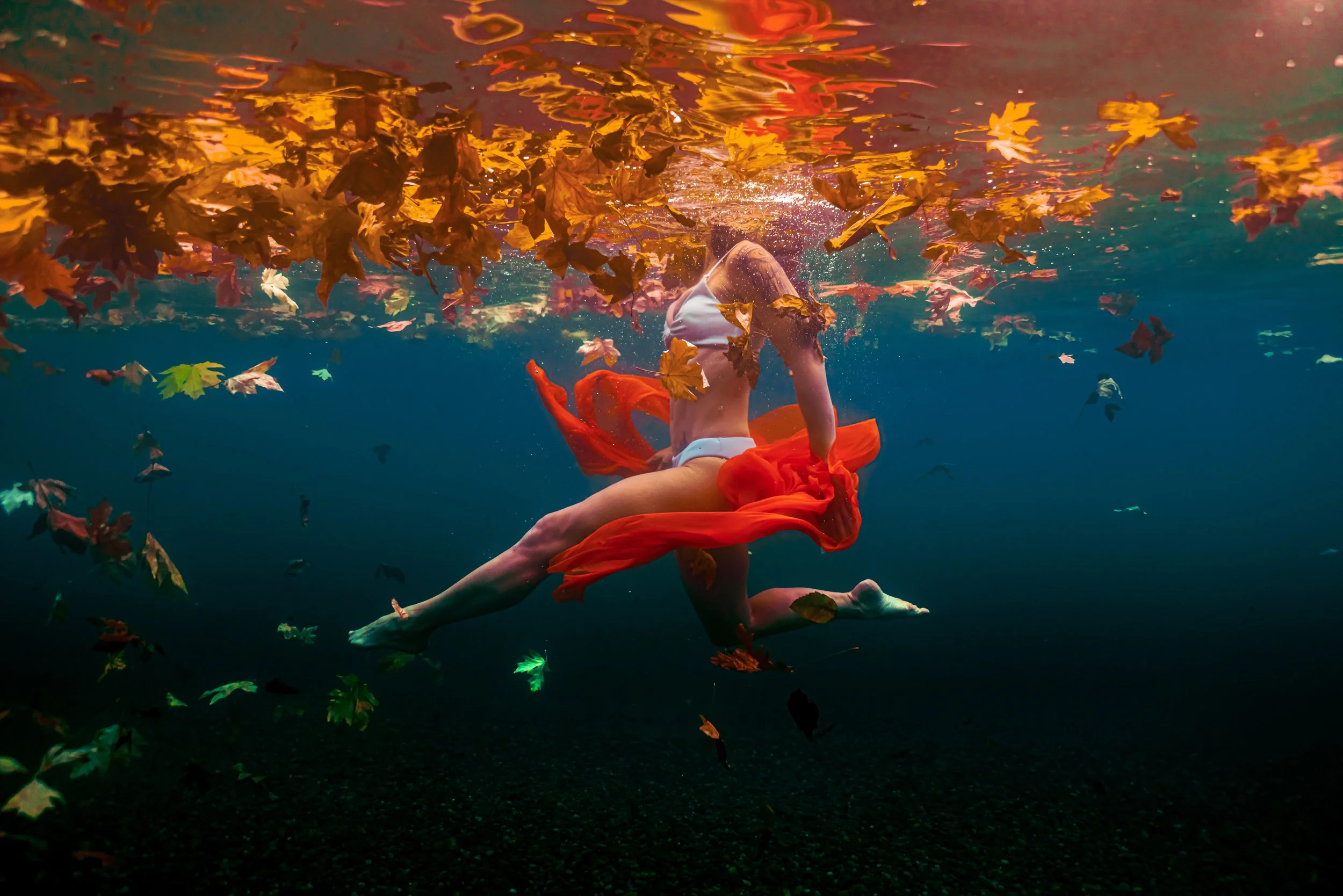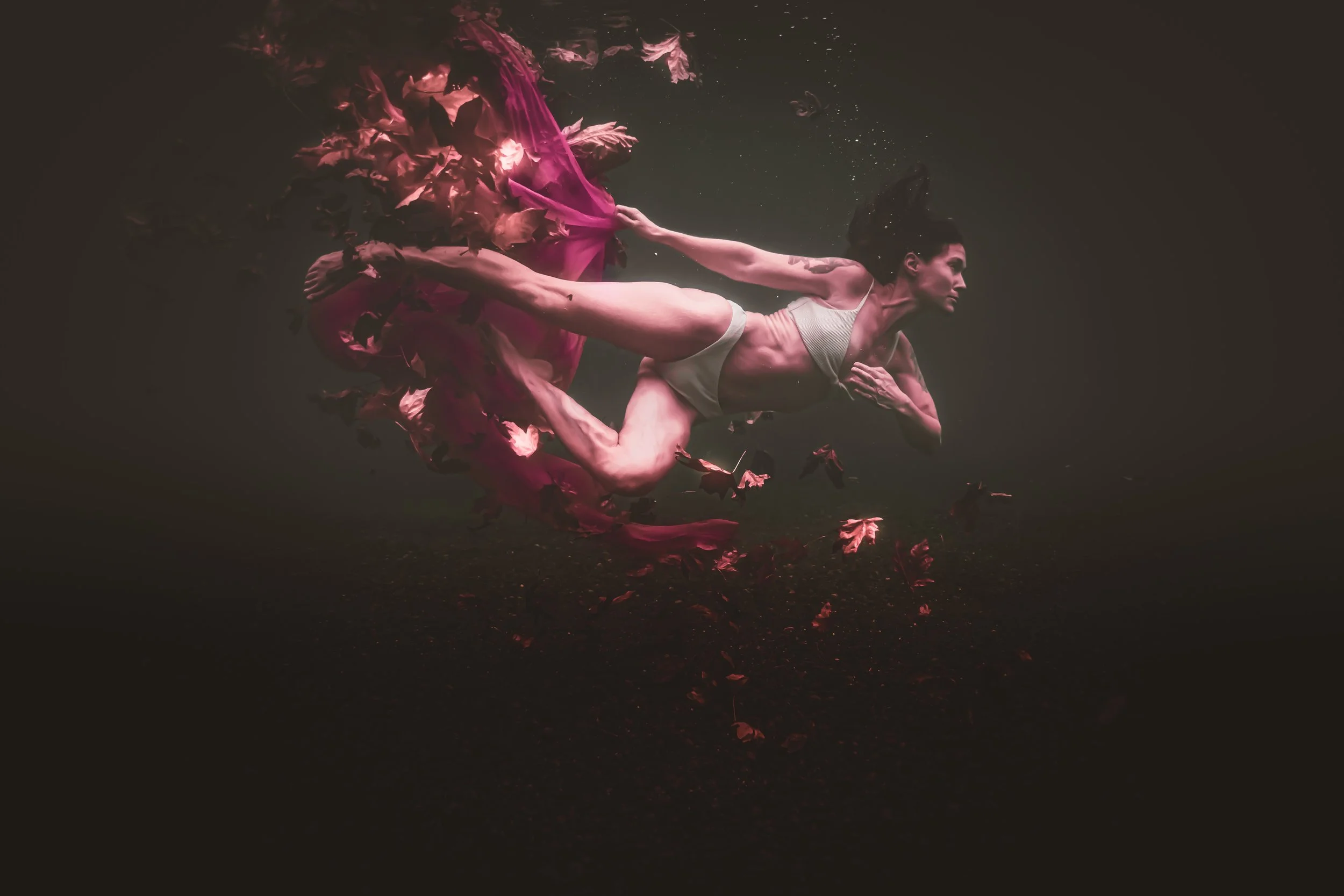Behind the Curtain
I thought I’d take a moment to share a little bit of the “how its done” here. It’s not voodoo. But there is, maybe, a touch of magic that has to be present.
Let’s start with the environment.
Upwards of 98% of the swim-art photos I shoot are taken off Owen Beach at Point Defiance in Tacoma, WA. We may shoot anywhere along the beach, including the tip of the point off the clay banks. And sometimes far enough off shore to be in 200+ feet deep of water (max depth in the channel is around 550' feet, give or take.)
It is tidal salt water and the water temperature spans about 48 degrees at the low and maybe 55 in the height of summer. That is always radically influenced by tide too, and the deep channel that keeps a lot of cold water. In some areas not far away, long, shallow sea floor shelves might bank up a lot of solar heat and keep a water temp as warm as the low 60’s. But for all of these shoots, we are generally in an area that will stay about as cold as these local waters will be.
If we elect to go closer to the tip of the point, we’ll usually be going after images that include bull kelp (when in season). The point also tends to carry a pretty healthy seal and sea lion population. And in some years we might even get a roosting Bull Stellar sea lion. Looks like that might be the case this year. When that is true, I tend to avoid the point and give a wide berth to the resident bull. That’s a big animal and very territorial. They move about and stake their claim in different spots most seasons, with a few exceptions. Just a couple of weeks ago, a bull showed up just as we were entering the water. He swam aggressively back and forth, posturing and putting up quite the display. That is, until a female swam by and distracted him. But 20 minutes later, he was back, just as we were wrapping up and exiting the water.
Choreographing the shoot.
Since these shoots feature “no wetsuits”, we don’t get a whole lot of time to waste. So we’ll often sit and talk about a plan before we get in the water. I’ll look at the overall conditions….water clarity, overhead sunlight or clouds, current, wind and surface conditions…and then think about how that all plays into the shot.
Depending on the swimmer, the collaborative nature of the shoot will take shape from there. Of the last year, I’ve done a lot of shooting with Jill (image below). She is an artist and art teacher by profession, with a background in dance and gymnastics from her younger years. So she brings an eye toward composition to the table, and together we can talk through an idea with the hopes of creating curated images once in the water.
For the most part, we usually have about 20 minutes to work in the water, before things get too cold to carry on. And because the best shots tend to come in the late Fall and Winter months (for ultimate water clarity), then we are also working with the coldest water of the year; generally in that 48 - 50 degree range. (I swear I can always tell the day that the water temp dips from 50 to 49. There is just something notable about that one degree change. The cold of the water has an added bite to it. Hands hurt for a bit while getting acclimated.) And the part about water clarity? Summer warmth brings about naturally occurring algaes to the water. So it gets very speckled and cloudy looking. Some days you can barely see a few feet. While others, maybe you can see 20 - 30 feet.
Anyway - correographing.
It’s always best to talk about the vision for the day. Talk through the steps to achieve certain poses, and the ideas or spirit of the shoot. With limited time, it’s wise to at least head into the water with a basic sense of where we think things can go. That can always change (and sometimes does) once in the water. Maybe the situation surprises us, changes or just otherwise isn’t what we thought it might be. Maybe some sun rays open up and change the direction of the day. Or maybe it’s darker than thought. It could be any number of things. But still, we talk about the goals and sometimes even rehearse them on land a few times. (Sometimes if there is a breeze and we are using fabric, we can mock-run the effects of the fabric in the breeze, as though it was water current.)
Props.
This year we started testing a few props. A dress. A sarong. A pile of golden/ yellow Fall leaves. This is where things start to get considerably more complicated. When introducing fabrics into the water, an element of risk elevates with it. The fabric is cumbersome, acts like a sail, an anchor, a straight jacket, a tourniquet….pick your problem. The more the fabric, the bigger the problems. Then add current. Staying untangled is a real thing.
And let’s check back in with the cold. You can talk through all the plans you want, but when that cold water goes into your ears - reality changes. Breath gets short. The panic button illuminates. Fight or flight mechanisms start to tingle.
For me…from the backside of the camera…it’s about working around the burst of chaos while also helping influence some calm. Helping the swimmer settle down, calm and relax their face, and find the space to move through the reduced gravity. From there, I try to just be present, observe the motions and the environment, and focus on framing the best shots I can. It’s tricky when shooting motion while in motion. Buoyancy wants to pull me up, while I am fighting to go down. I may only have one hand somewhat free…but usually am trying to control the camera with both hands, while using my feet to propel me in whatever direction is required.
While all this is happening, I am watching the swimmer move, watching the light refract through the water column, watching bubbles rise and trying to maintain my position relative to the subject. A million moments happening at the speed of light, and I am clicking away photos, hoping to capture them all.
In between breaths, its back to the surface where we recompose, and if there is fabric in the scene, try not to get tangled up and drown! A few moments of focus and recollect…..then 3…2…1…..down again. Swim an arc…..do a somersault….dive and spin….drop straight down….blow bubbles….so many things to do or try, while seeking equilibrium with the surroundings. I love it.
Wrapping Up
Around the 20 minute mark, its usually time to head in. The shivers get deep after that, and re-warming takes a lot of time. In Jill’s case, she’ll start with a bucket of hot water to rinse off. Then a couple of hot water bottle/ bladders to tuck under warm dry cloths, followed by a thermos of hot coffee. Warming from the outside in and the inside out. Other swimmers (like Melissa) prefer to go for a trail run after to regenerate warmth.
For me, now it’s time to also get changed into dry cloths, while safely packing away the camera. If it was an exceptional shoot, I’ll usually sit for a few minutes and take a sneak peek at what’s on the memory card. It’s hard to contain the excitement. Once home, all the gear moves into the shower to get de-salt-watered and clean, while the camera downloads over to the computer where I’ll spend part of the day reviewing and editing.
The Images Below
Wew captured this one yesterday morning, and you can see some other samples from this shoot in the portfolio page on this site and also in the last blog post before this one. Jill had procured some chiffon fabric and wrapped it up like a sarong. The effects were stunning. In some instances, the fabric almost looked like a liquid being injected into the sea - like an old school lava lamp.
The second and third image shows how we incorporated the leaves. This was Jill’s idea. We started on shore by collecting a large pile of golden yellow leaves, then setting them free into the water. This was challenging! We had a lot going on at once, and a water current that was running entirely opposite of what we expected. How the leaves behaved was interesting and we had to react to that, rather than truly control it. But as you can see, we were able to create a variety of scenes, vibes and feelings.
Alright. That’s about it for now.
More as winter marches on….
~Dean


